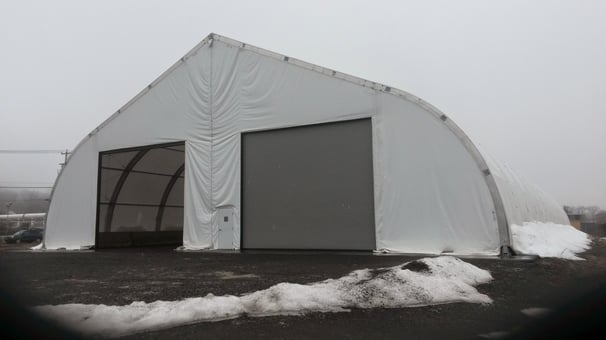Weather is ever changing, as most everything in life is situational, dependent upon a particular time and place. It can rain, snow, sleet, hail and be sunny all within a matter of hours. It is this unpredictability that can halt many projects or damage existing worksites. From construction site delays due to unacceptable working conditions, to damaged products or goods in a warehouse, extreme weather can be bad news. The best way to prevent this from destroying a project timeline is to prepare for the worst.
With hurricane season in full force and the generally volatile nature of fall-to-winter weather, it’s vital to be knowledgeable and prepared for whatever may come your way, no matter the region in which your warehouse, worksite or terminal is located. Temporary fabric structures able to withstand any weather condition are ideal for companies that need to keep operations running year-round, or possibly during extreme weather months only, which can be virtually any time of the year.
A key element of weather-resistant structures is the material it is constructed with. Structures built using durable yet flexible components are essential, because the material is better equipped to handle extreme weather conditions. Depending on the frame size and engineering completed, some fabric structures can endure winds of 130-plus miles per hour and snow loads upward of 30 pounds per square foot. These structures can withstand the elements regardless of the environment, and they can fulfill the needed site and building code requirements. Additionally, these structures allow companies to save time by enabling workers to continue operations in any condition — be it extreme heat or severe cold.

Insulation is an important element/ option to consider as well. The R-value, or the measure of thermal resistance, of a structural installation is based on the environment. If your project is in a warmer area, a lower R-value is required than if you were in a colder area performing the work. Another element that should be considered is the landscape — for example, whether it is near-frozen ground or retains intense heat. Based on all environmental factors, the installation team can devise a plan to ensure proper setup of the structure in a timely and cost-effective manner.
Extreme weather structures are not only capable of withstanding the elements but also built to International Building Code requirements and therefore should be certified by a licensed engineer. The safety of your workers, especially while the structure is in use, should never be a concern. Extreme weather planning should not only cover times of extraordinary or spontaneous events; it also has to be thought of when arranging the location of your operations, be it a lunch tent, warehouse, etc. Whether it’s a potential hurricane and immediate shelter is needed, or you need to plan for upcoming seasonal work in the frigid north, extreme weather preparations must be considered in your strategic plan.
When seeking temporary and semi-permanent industrial fabric structures, look for a company with a documented history of innovation and excellence that can provide safe and compliant tent solutions. Such a company should hold ISNetworld, HAZWOPER, TWIC, DISA (Defense Information Systems Agency), PICS (Pacific Industrial Contractor Screening) and OSHA certifications, as well as site-specific credentials, to ensure the safety of its employees and your workforce on-site.
Interested in learning more about industrial fabric structure solutions and how to protect your assets from harsh weather?
This article originally appeared in BIC magazine.
